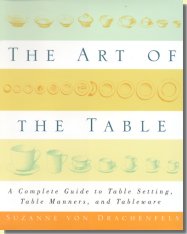 Excerpt
from The Art of the Table: A Complete Guide to Table Setting, Table Manners, and Tableware
Excerpt
from The Art of the Table: A Complete Guide to Table Setting, Table Manners, and Tableware
by Suzanne von Drachenfels
HOW TO LAY DINNERWARE
All human history attests
That happiness for man,
The hungry sinner;
Since Eve ate apples
Much depends upon dinner.
Lord Byron, Don Juan
The dinner table is the heart of the home, a magic place where moments are treasured and memories made. Family events, anniversaries, and holidays are all celebrated at the table, a place where children are taught, business is conducted, and romance is found, a setting that greets with a silent message: "Welcome. A place is prepared for you."
A myriad of traditions surround the service of meals, especially dinner. We dine in a designated area and sit at a table enhanced by the symmetrical alignment of dinnerware. Like a picture slightly askew, an asymmetrical place setting creates subtle irritation, and to promote a harmonious relaxed ambience, dinnerware is laid directly opposite the ware on the other side of the table. When an odd number of people are seated at a rectangular, square, or oval table, the odd-numbered place setting is aligned with the middle of the even-numbered place setting opposite. This is not to suggest that one set the table with a ruler in hand, only that the symmetrical alignment of dinnerware please the eye.
The type of dining occasion determines where to lay dinnerware. At a multi-course meal, notably a formal affair, each course is served one at a time, and dinnerware is laid in the center of the place setting. In formal dining, side dishes are not used, cups and saucers do not appear on the table, and demitasse is served in another room.
At an informal meal, the menu is simpler and the courses are either laid on the table all at once or presented one at a time as in formal service. A meal served all at once requires space, and side dishes, namely, salad plate, bread-and-butter plate, and fruit saucer, are laid to the left of the cover. The left-handed person reverses the placement. Why are side dishes placed opposite the hand with which one eats? Because the placement of ware near the "eating" hand is awkward to manipulate and makes the dishes too close for comfort.
The placement of the cup and saucer is different for company and family dining. Because the majority of people are right-handed, at a company occasion the cup and saucer are placed on the right side, even for a left-handed person; this placement promotes a symmetrical table setting. The cup and saucer are laid to the right of the outside piece of flatware. However, at a family meal, aesthetics are not as important as comfort, and commonsense dictates seating the left-handed person at the end of the table where the cup and saucer are placed on the left (even though the other cups and saucers are on the right).
When hot beverages are served during a meal, such as coffee at breakfast or tea at lunch, the cup and saucer are laid on the table initially. But if hot beverages are served at the end of a meal, such as after dessert, the cup and saucer are brought to the table following the last course.
Here are some guidelines for the alignment of dinnerware.
• Large plates, such as the dinner plate and luncheon plate, are laid about 1 inch in from the edge of the table. The exception is the service plate, a capacious plate aligned flush with the edge of the table.
• Small plates, such as the salad plate, fish plate, and dessert plate, are laid in the center of the cover, about 2 inches in from the edge of the table.
• Cups and saucers are placed approximately 1 inch beyond the outermost piece of flatware. The top edge of the saucer is aligned with the top rim of the plate or bowl.
• Cup handles are faced in a four o'clock position for easy access.
• Soup bowl and soup cup handles are aligned parallel with the edge of the table.
• Bread-and-butter plates are laid at the top left of the cover, usually above the dinner fork, a placement that avoids overcrowding on the right side, where the goblet and wine glass are placed.
• Elbow room requires a minimum of 15 inches between place settings, or approximately 24 inches from the center of one place setting to the middle of the next.
Copyright © 2005 Suzanne von Drachenfels
For more information, please visit www.tabletalk.org.
